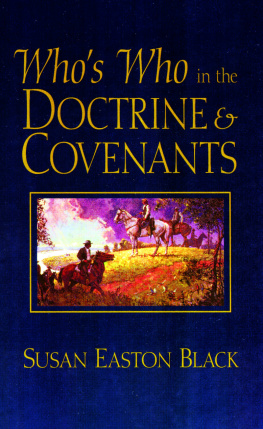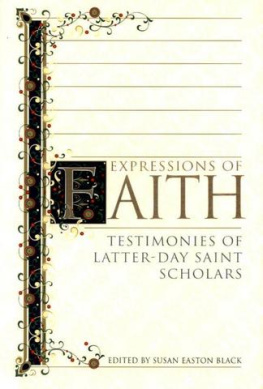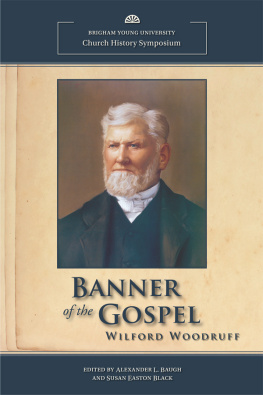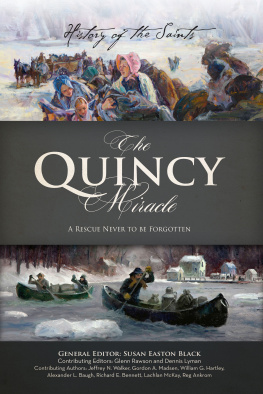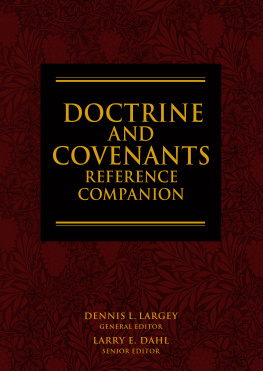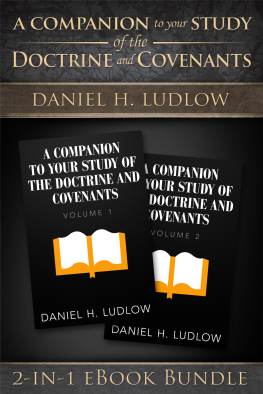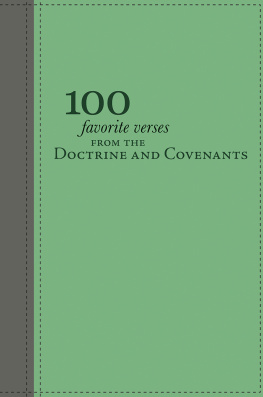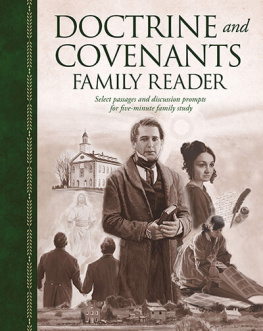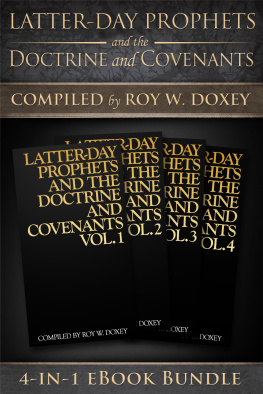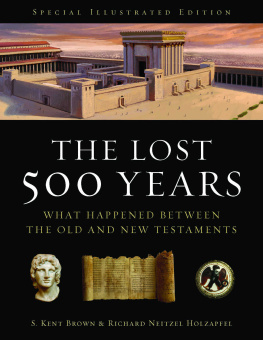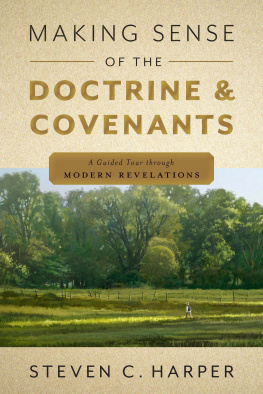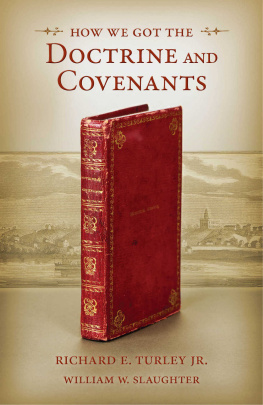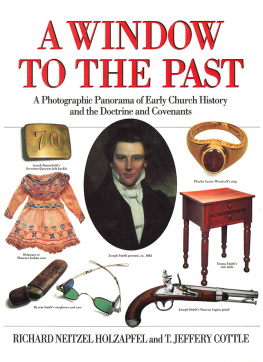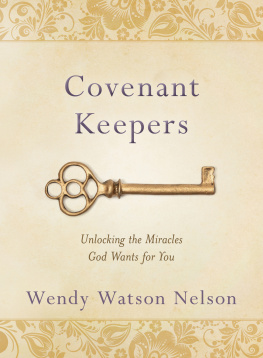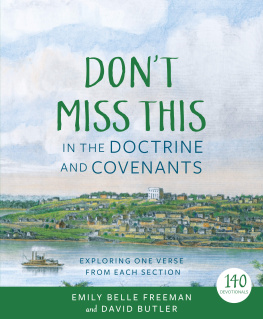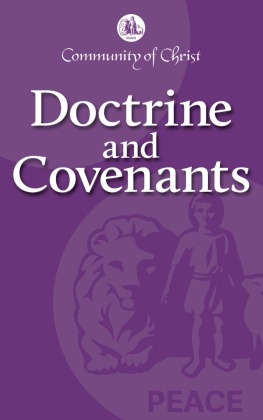Who's Who in the Doctrine and Covenants
Susan Easton Black
1997 Susan Easton Black.
All rights reserved. No part of this book may be reproduced in any form or by any means without permission in writing from the publisher, Deseret Book Company, P.O. Box 30178, Salt Lake City Utah 30178. This work is not an official publication of The Church of Jesus Christ of Latter-day Saints. The views expressed herein are the responsibility of the author and do not necessarily represent the position of the Church or of Deseret Book. Deseret Book is a registered trademark of Deseret Book Company.
Introduction
Introduction
For many years I have wished that someone living in the New Testament era had written about the followers of Jesus. To know something more than the mere scriptural mention of Anna, Joanna, the widow of Nain, and Simeon would have blessed and inspired generations.
Not wanting history to repeat itself, I began researching the lives of the 136 individuals mentioned by name in the Doctrine and Covenants. I believe the Lord included the names of those who made solemn covenants and who associated with the Prophet Joseph Smith for a purpose. One purpose might be for readers to gain additional insights to determine why one man was called on a mission to the south and another to the north, why one would be assigned to be a recorder while another was designated a printer, and why some men were worthy to receive the Melchizedek Priesthood in the early 1830s while others needed to wait.
Who's Who in the Doctrine and Covenants represents untold hours of library research, visits to historical sites, and years of correspondence with descendants of those mentioned in the Doctrine and Covenants. Reading microfilms of census records and property deeds may lack appeal for some authors, but it has been a great discovery in joy for me. It has given me new insights, greater understanding, and a deeper appreciation of the Lord's purpose in the revelations contained in the Doctrine and Covenants.
It is my hope that this book may be read and enjoyed and used as a reference book for years.
Susan Easton Black is a professor of Church History and Doctrine and an associate dean in General Education and Honors at Brigham Young University.
Major Noble Ashley
D&C 75:17
Birth: 3 March 1798, Sheffield, Berkshire County, Massachusetts. Son of Oliver Ashley and Tabitha Baker.
In the early 1800s parents often named their sons ennobling, honorific titles. Major was such a title and does not signify military status. Just as King Follett was never a king, neither was Major Noble Ashley a commander in the military.
Little is known of Major's early years as he grew to manhood in Massachusetts. By 1831 he had joined the Church and been ordained a high priest. Pleased with his ordination, he pronounced that "it was by the help of the Lord that he had been preserved, yet his greatest fear was for those who were weak in the faith." Although his testimony was meant for the backslider, it proved to be a precursor of his own weak conviction.
Confident in his faithfulness, Major submitted his name to the Prophet Joseph Smith, seeking to know the will of the Lord concerning him (see D&C 75:23). The Lord revealed on 25 January 1832, "And again, I say unto my servant Major N. Ashley, and my servant Burr Riggs, let them take their journey also into the south country" (D&C 75:17). Major, as well as other elders present when Joseph received the revelation, was promised that if faithful he would be "laden with many sheaves [meaning many baptisms], and crowned with honor, and glory, and immortality, and eternal life" (D&C 75:5).
Whether he journeyed to the "south country" is not known. Less than six months later, on 3 July 1832, he was present at the home of Edward Partridge in Independence, Missouri, and was laboring as a tanner.
The Ohio federal census of 1840 reported that Major was living in Tallmadge, Summit County, with two females, one between fifty to sixty years of age and the other between eighty to ninety years. In the census his trade was listed as a miner-a "learned professional and engineer." Although recognized by worldly standards for his profession, Major forfeited his testimony and quickly became one of those for whom he had once feared: "those who were weak in the faith."
Notes
Every effort has been made to find a military status for the name. The census of 1840 in Ohio lists his first name as Major.
Donald Q. Cannon and Lyndon W. Cook, eds., Far West Record: Minutes of The Church of Jesus Christ of Latter-day Saints, 1830-1844 (Salt Lake City: Deseret Book Co., 1983), p. 22.
Oliver Cowdery recognized his skills and corresponded with him about leather products.
See Donald Q. Cannon and Lyndon W. Cook, eds., Far West Record: Minutes of The Church of Jesus Christ of Latter-day Saints, 1830-1844 (Salt Lake City: Deseret Book Co., 1983), pp. 7-8.
Almon Whiting Babbitt
D&C 124:84
Birth: 1 October 1812, Cheshire, Berkshire County, Massachusetts. Son of Ira Babbitt and Nancy Crosier (Crasier).
Death: 7 September 1856, near Ash Hollow, about one hundred miles northeast of Fort Kearny, Nebraska.
Almon Babbitt received a blessing from the Prophet Joseph Smith for his willingness to march with Zion's Camp. Benjamin Johnson wrote, "Joseph ... told [Almon] of much good he would do in preaching the gospel, and how the hearts of people would be drawn towards him, and the greatness to which he would attain." Through the years this blessing was realized, even though he failed to listen to prophetic counsel.
During his first eight years in the Church, Almon struggled to comply with Church leadership. After his ordination on 28 February 1835 to the First Quorum of Seventy, he was rebuked by the Kirtland high council: "A charge was preferred ... against Elder Almon W. Babbitt, for not keeping the Word of Wisdom; for stating the Book of Mormon was not essential to our salvation, and that we have no articles of faith except the Bible."
Almon countered that "he had taken the liberty to break the Word of Wisdom, from the example of President Joseph Smith, Jun., and others, but acknowledged that it was wrong."
In 1838 Almon was again rebuked by the Prophet for leading a company of Canadian Saints to Missouri and settling "on the forks of Grand river ... contrary to counsel" Almon was disfellowshipped and his preaching license demanded.
By 5 September 1840 three additional charges were brought against him before the high council in Nauvoo:
First. For stating that Joseph Smith, Jun., had extravagantly purchased three suits of clothes while he was at Washington City, and that Sidney Rigdon had purchased four suits while at the same place, besides dresses in profusion for their families.
Second. For having stated that Joseph Smith, Jun., Sidney Rigdon and Elias Higbee had said that they were worth one hundred thousand dollars each, while they were at Washington....
Third. For holding secret councils in the Lord's House, in Kirtland, and for locking the doors of the house, for the purpose of prohibiting certain brethren in good standing in the Church, from being in the Council, thereby depriving them of the use of the house.
After these charges were reconciled, Almon was called on 19 October 1840 to be president of the Kirtland Stake. In a joint letter signed by Joseph and Hyrum Smith, they wrote: "We therefore hope that the Saints will hold up the hands of our beloved brother, and unite with him in endeavoring to promote the interests of the kingdom."

